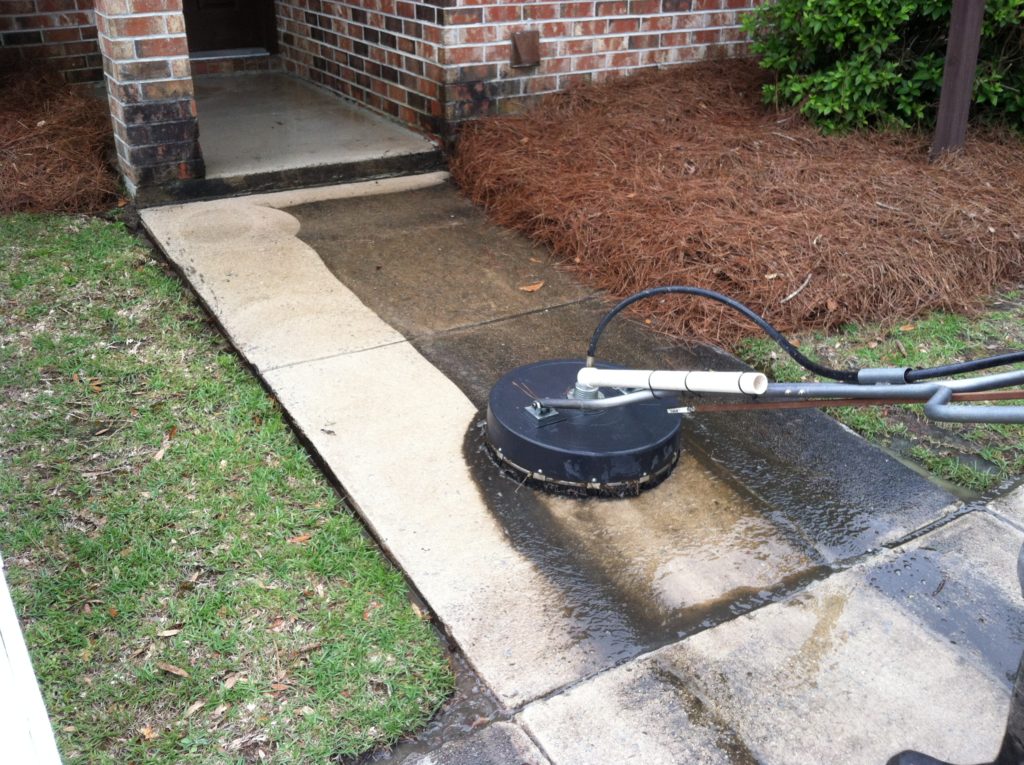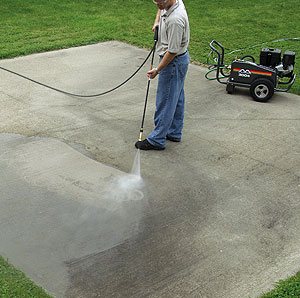For cleaning concrete, a pressure washer should have a PSI rating between 3000 and 4000. This range ensures effective removal of dirt, stains, and grime.
Concrete surfaces often accumulate tough stains and dirt over time. A high-quality pressure washer can restore their original appearance quickly. Using the right PSI is crucial for effective cleaning without damaging the surface. Pressure washers in the 3000-4000 PSI range deliver the necessary power to tackle stubborn grime.
Beyond PSI, consider other factors like flow rate and nozzle type for optimal results. Proper technique also plays a role in achieving a clean finish. Selecting the right equipment not only saves time but enhances the lifespan of your concrete surfaces, making regular maintenance easier.

Credit: www.hotsyab.com
Page Contents
- 1 The Importance Of Choosing The Right Psi
- 2 Types Of Pressure Washers
- 3 Psi Explained
- 4 Concrete Cleaning Challenges
- 5 Optimal Psi For Concrete Surfaces
- 6 Pressure Washing Techniques
- 7 Safety Measures During Pressure Washing
- 8 Maintenance And Care Of Pressure Washers
- 9 Frequently Asked Questions
- 10 Conclusion
The Importance Of Choosing The Right Psi
Choosing the right psi for a pressure washer is very important. It affects how well concrete surfaces are cleaned. Incorrect psi can lead to damage.
Factors that influence psi selection include:
- Surface type: Different concrete surfaces need different pressures.
- Stains: Tough stains may require higher psi to remove.
- Age of concrete: Older concrete can be more fragile.
Risks of using incorrect psi include:
- Surface damage: Too high psi can chip or crack concrete.
- Inadequate cleaning: Too low psi won’t remove dirt and stains.
- Increased costs: Damage may require expensive repairs or replacements.

Credit: www.aspenpowerwashing.com
Types Of Pressure Washers
Two main types of pressure washers exist: electric and gas models. Electric units are lighter and easier to use. They are quieter and produce less emission. Gas models provide more power for tough jobs. They are better for large areas and heavy-duty tasks.
Pressure washers also differ for commercial and residential use. Commercial units are built for frequent use and higher demands. They often have more robust features and higher PSI ratings. Residential units are perfect for home tasks like cleaning patios and driveways.
Psi Explained
Pressure per square inch, or PSI, is important for cleaning. It measures the force of water from a pressure washer. Higher PSI means more cleaning power. It helps to remove dirt, grime, and stains effectively.
Understanding PSI levels is key. For concrete surfaces, a minimum of 3000 PSI is recommended. This level can break down tough stains and embedded dirt. Lower PSI levels may not clean concrete effectively.
The relationship between PSI and cleaning efficiency is direct. Higher PSI leads to better cleaning results. However, too much pressure can damage surfaces. Always choose the right PSI for the job.

Credit: www.reddit.com
Concrete Cleaning Challenges
Concrete surfaces often face tough cleaning challenges. Oil stains, rust, and mold are common issues. Each stain requires different cleaning methods. For instance, oil stains need degreasers, while rust may need special rust removers.
Mold and mildew thrive in damp areas. These require a pressure washer with a high PSI. Use hot water for better results against stubborn grime. Always check the concrete’s condition before cleaning.
Surface protection is crucial. Some concrete may chip or crack under high pressure. Using the right nozzle and distance helps prevent damage. Always test a small area first.
Optimal Psi For Concrete Surfaces
The optimal psi for cleaning concrete surfaces is essential. A recommended psi range is between 2,500 and 3,000 psi. This level effectively removes dirt and stains without damaging the surface.
Adjusting psi is important for different concrete types. For soft concrete, use a lower psi, around 1,500 to 2,000 psi. For stained or sealed concrete, stick to 2,500 to 3,000 psi. Always test in a small area first.
| Concrete Type | Recommended PSI |
|---|---|
| Soft Concrete | 1,500 – 2,000 psi |
| Standard Concrete | 2,500 – 3,000 psi |
| Stained/Sealed Concrete | 2,500 – 3,000 psi |
Pressure Washing Techniques
Pressure washing concrete requires specific techniques for best results. Effective sweeping patterns ensure thorough cleaning. Start from one corner and move in straight lines. Overlap each pass slightly to avoid streaks. This method helps remove dirt and grime efficiently.
Using detergents with high PSI enhances cleaning power. Choose a detergent that is safe for concrete surfaces. Apply it before pressure washing to loosen tough stains. Wait a few minutes for the detergent to work. Then rinse with high-pressure water for a spotless finish.
Safety Measures During Pressure Washing
Using a pressure washer can be fun and effective. Always wear safety goggles to protect your eyes. Gloves are essential to keep your hands safe from chemicals. Steel-toed boots help protect your feet from heavy equipment. A mask can prevent inhaling harmful substances.
To prevent damage to surrounding areas, cover plants and furniture. Use plastic sheets to shield delicate items. Move furniture away from the washing area. Ensure that windows and doors are closed tightly. Check for loose items that could be damaged by water pressure.
Maintenance And Care Of Pressure Washers
Regular upkeep is key for a long-lasting pressure washer. Check the oil level often. Clean the filter and replace it if needed. Inspect hoses for any damage or leaks. Keep the nozzles clean to ensure proper spray patterns.
Winter storage requires special care. Drain all water from the machine. Store it in a dry place to avoid freezing. Use a cover to protect it from dust and dirt.
| Common Issues | Troubleshooting Steps |
|---|---|
| Machine won’t start | Check the power source and reset the switch. |
| Low pressure | Inspect the nozzle and clean or replace it. |
| Water leaks | Tighten fittings and check hoses for cracks. |
Frequently Asked Questions
What Psi Pressure Washer Is Best For Concrete?
A pressure washer with a PSI rating between 3000 and 4000 is ideal for cleaning concrete surfaces. This range effectively removes dirt, grime, and stains without damaging the concrete. Always consider using a suitable nozzle for better cleaning results.
Can I Use A Lower Psi On Concrete?
Yes, you can use a lower PSI, but it may take longer. A pressure washer with 2000 to 2500 PSI can clean concrete but may not remove tough stains. For optimal results, choose a higher PSI for efficient cleaning without compromising the surface.
How Often Should I Pressure Wash My Concrete?
Generally, it’s advisable to pressure wash concrete surfaces at least once a year. However, high-traffic areas may require more frequent cleaning. Regular maintenance prevents buildup and prolongs the life of your concrete, keeping it looking fresh.
What Nozzle Should I Use For Concrete Cleaning?
For concrete cleaning, a 25-degree or 40-degree nozzle is recommended. The 25-degree nozzle provides a more concentrated spray for tough stains, while the 40-degree nozzle is better for general cleaning. Always test a small area first to ensure you don’t damage the surface.
Conclusion
Choosing the right PSI pressure washer for concrete is crucial for effective cleaning. Higher PSI levels typically deliver better results on tough stains and grime. Always consider your specific needs and the type of concrete surface you’re working with. Investing in the right equipment will ensure your surfaces remain pristine for years to come.

